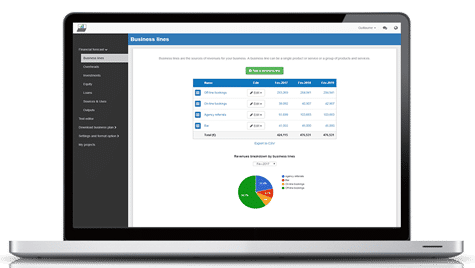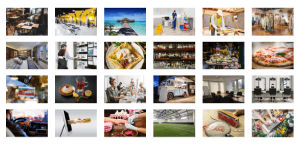How to create a financial forecast for a campsite?
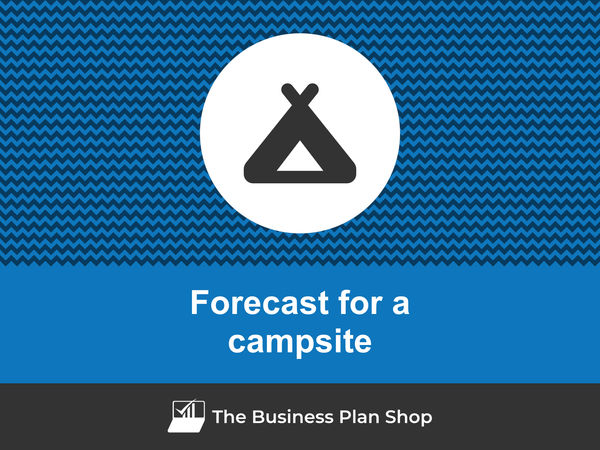
If you are serious about keeping visibility on your future cash flows, then you need to build and maintain a financial forecast for your campsite.
Putting together a campsite financial forecast may sound complex, but don’t worry, with the right tool, it’s easier than it looks, and The Business Plan Shop is here to guide you.
In this practical guide, we'll cover everything you need to know about building financial projections for your campsite.
We will start by looking at why they are key, what information is needed, what a forecast looks like once completed, and what solutions you can use to create yours.
Let's dive in!
Why create and maintain a financial forecast for a campsite?
Creating and maintaining an up-to-date financial forecast is the only way to steer the development of your campsite and ensure that it can be financially viable in the years to come.
A financial plan for a campsite enables you to look at your business in detail - from income to operating costs and investments - to evaluate its expected profitability and future cash flows.
This gives you the visibility needed to plan future investments and expansion with confidence.
And, when your trading environment gets tougher, having an up to date campsite forecast enables you to detect potential upcoming financing shortfalls in advance, enabling you to make adjustments or secure financing before you run out of cash.
It’s also important to remember that your campsite's financial forecast will be essential when looking for financing. You can be 100% certain that banks and investors will ask to see your numbers, so make sure they’re set out accurately and attractively.
Need a solid financial forecast?
The Business Plan Shop does the maths for you. Simply enter your revenues, costs and investments. Click save and our online tool builds a three-way forecast for you instantly.
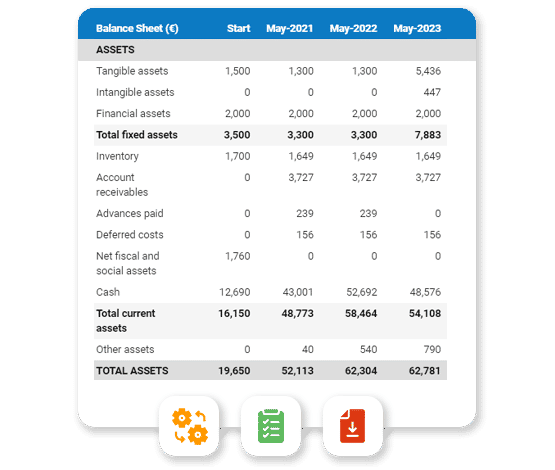
What information is used as input to build a campsite financial forecast?
A campsite's financial forecast is only as good as the inputs used to build it.
If you are creating (or updating) the forecast of an existing campsite, then you mostly need your accounting information, key historical operating non-financial data, and your team’s input on what to expect for the coming years.
If you are building financial projections for a campsite startup, you will need to have done your research and have a clear picture of your competitive environment and go-to-market strategy so that you can forecast sales accurately.
For a new venture, you will also need a precise list of the resources needed to keep the campsite running on a day-to-day basis and a list of the equipment and expenditures required to start the business (more on that later).
Let's now take a closer look at the elements that make up your campsite's financial forecast.
The sales forecast for a campsite
From experience, it is usually best to start creating your campsite financial forecast by your sales forecast.
To create an accurate sales forecast for your campsite, you will have to rely on the data collected in your market research, or if you're running an existing campsite, the historical data of the business, to estimate two key variables:
- The average price
- The number of monthly transactions
To get there, you will need to consider the following factors:
- Seasonal Demand: As a campsite owner, you know that your business is heavily influenced by the seasonal demand for camping. During peak camping season, you can expect to charge higher prices and have more monthly transactions compared to off-season months.
- Weather Conditions: Unpredictable weather conditions can have a significant impact on your campsite's sales forecast. Adverse weather, such as heavy rain or extreme heat, can deter potential campers and lead to a decrease in both average price and monthly transactions.
- Competitors: The presence of other campsites in the area can also affect your business's average price and monthly transactions. If you have direct competitors nearby, you may need to adjust your prices to remain competitive and attract customers.
- Infrastructure Improvements: Any improvements or additions to your campsite's infrastructure, such as upgraded facilities or new recreational activities, can attract more customers and potentially allow you to charge higher prices.
- Local Events and Festivals: Your campsite's location may also play a role in its sales forecast. If your campsite is located near popular events or festivals, you may see an increase in demand and be able to charge higher prices during those times.
Once you have an idea of what your future sales will look like, it will be time to work on your overhead budget. Let’s see what this entails.
Need inspiration for your business plan?
The Business Plan Shop has dozens of business plan templates that you can use to get a clear idea of what a complete business plan looks like.
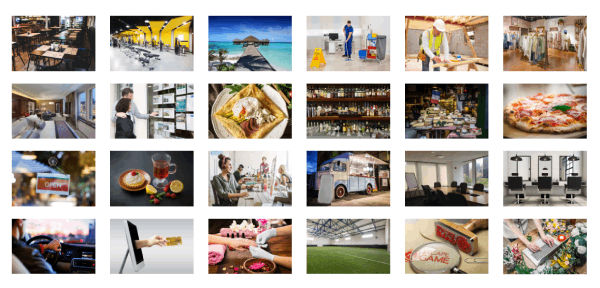
The operating expenses for a campsite
The next step is to estimate the costs you’ll have to incur to operate your campsite.
These will vary based on where your business is located, and its overall size (level of sales, personnel, etc.).
But your campsite's operating expenses should normally include the following items:
- Staff costs: This includes salaries, wages, and benefits for all campsite employees, including camp counselors, maintenance staff, and administrative staff.
- Accountancy fees: You will need to hire an accountant to handle tax preparation and financial reporting for your campsite.
- Insurance costs: It is important to have insurance to protect your campsite from liability and property damage.
- Software licences: You may need to purchase software licences for programs such as booking and reservation systems, accounting software, and point of sale systems.
- Banking fees: There may be fees associated with maintaining a business bank account and processing credit card payments.
- Marketing and advertising: You will need to budget for marketing and advertising expenses to attract campers to your site.
- Utilities: This includes electricity, water, and gas for your campsite facilities.
- Supplies: You will need to purchase supplies such as toiletries, cleaning supplies, and office supplies for your campsite.
- Maintenance and repairs: It is important to budget for regular maintenance and any unexpected repairs that may arise.
- Food and beverage: If your campsite offers meals or snacks, you will need to budget for food and beverage expenses.
- Property taxes: You may be required to pay property taxes on your campsite land and buildings.
- Equipment rental: If you do not own all of the equipment needed for your campsite, you may need to budget for equipment rental expenses.
- Pest control: It is important to keep your campsite free of pests, so budget for any necessary pest control services.
- Training and development: Invest in your staff by budgeting for training and development opportunities.
- Cleaning services: If you do not have the resources to handle cleaning yourself, you may need to hire a cleaning service for your campsite.
This list is not exhaustive by any means, and will need to be tailored to your campsite's specific circumstances.
What investments are needed to start or grow a campsite?
Your campsite financial forecast will also need to include the capital expenditures (aka investments in plain English) and initial working capital items required for the creation or development of your business.
For a campsite, these could include:
- Tents: As a campsite owner, you will need to invest in high-quality tents for your guests. These can range from basic one-person tents to larger family-sized tents. Make sure to consider durability, weather resistance, and ease of setup when choosing which tents to purchase.
- Picnic Tables and Benches: Providing a comfortable and functional outdoor dining area is important for campers. Invest in sturdy and weather-resistant picnic tables and benches that can accommodate groups of varying sizes.
- Fire Pits and Grills: Campfires and outdoor grilling are essential parts of the camping experience. Make sure to invest in fire pits and grills that are safe and easy to use for your guests. You may also consider purchasing firewood and grilling supplies for sale at your campsite.
- Bathroom and Shower Facilities: Clean and well-maintained bathroom and shower facilities are a must for any campsite. Depending on the size of your campsite, you may need to invest in multiple facilities to accommodate all of your guests.
- Playground Equipment: If you are catering to families with children, investing in playground equipment can be a great addition to your campsite. Consider purchasing swings, slides, and other age-appropriate equipment that will keep children entertained and active during their stay.
Again, this list will need to be adjusted according to the size and ambitions of your campsite.
Need a convincing business plan?
The Business Plan Shop makes it easy to create a financial forecast to assess the potential profitability of your projects, and write a business plan that’ll wow investors.
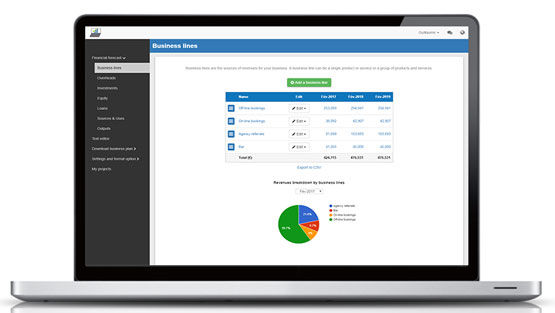
The financing plan of your campsite
The next step in the creation of your financial forecast for your campsite is to think about how you might finance your business.
You will have to assess how much capital will come from shareholders (equity) and how much can be secured through banks.
Bank loans will have to be modelled so that you can separate the interest expenses from the repayments of principal, and include all this data in your forecast.
Issuing share capital and obtaining a bank loan are two of the most common ways that entrepreneurs finance their businesses.
What tables compose the financial plan for a campsite?
Now let's have a look at the main output tables of your campsite's financial forecast.
The profit & loss forecast
The forecasted profit & loss statement will enable you to visualise your campsite's expected growth and profitability over the next three to five years.
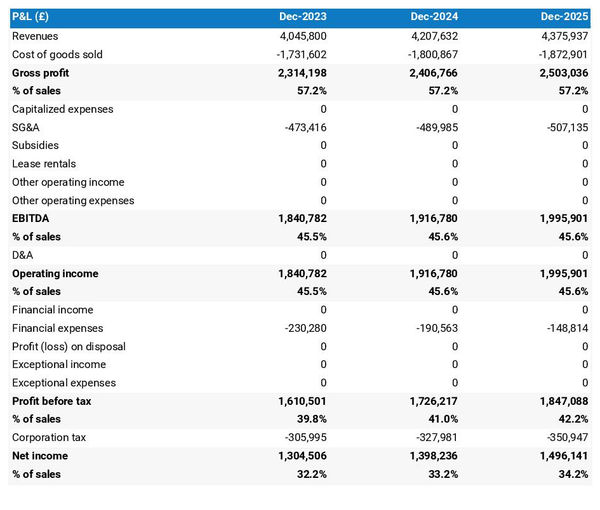
A financially viable P&L statement for a campsite should normally show:
- Sales growing above inflation
- Stable or expanding (ideally) profit margins
- A net profit
This will of course depend on the stage of your business: a new venture might be loss-making until it reaches its breakeven point in year 2 or 3, for example.
The projected balance sheet
Your campsite's projected balance sheet provides a snapshot of your business’s financial position at year-end.
It is composed of three types of elements: assets, liabilities and equity:
- Assets: represent what the business possesses including cash, equipment, and accounts receivable (money owed by clients).
- Liabilities: represent funds advanced to the business by lenders and other creditors. They include accounts payable (money owed to suppliers), taxes payable and loans from banks and financial institutions.
- Equity: is the combination of what has been invested by the business owners and the cumulative profits and losses generated by the business to date (which are called retained earnings). Equity is a proxy for the value of the owner's stake in the business.
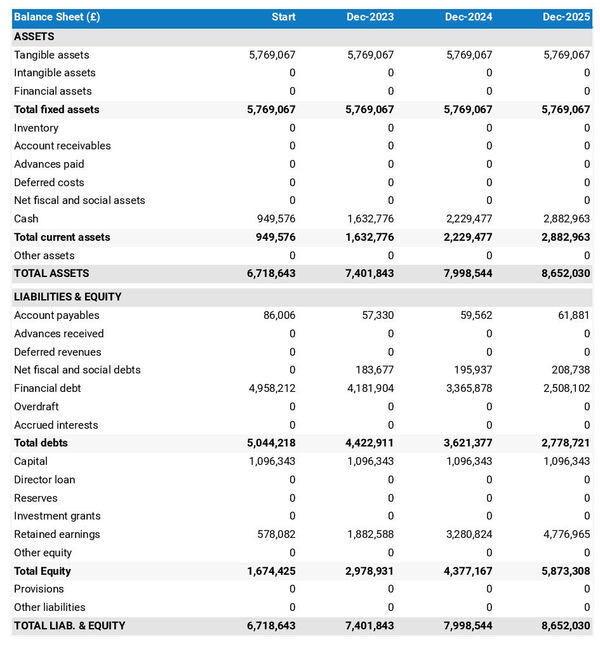
The cash flow projection
The cash flow forecast of your campsite will show how much cash the business is expected to generate or consume over the next three to five years.
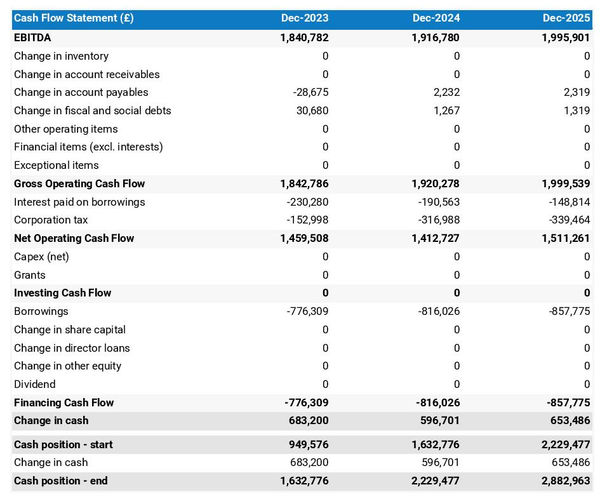
There are multiple ways of presenting a cash flow forecast but from experience, it is better to organise it by nature in order to clearly show these elements:
- Operating cash flow: how much cash is generated by the campsite's operations
- Investing cash flow: what is the business investing to expand or maintain its equipment
- Financing cash flow: is the business raising additional funds or repaying financiers (debt repayment, dividends)
Your cash flow forecast is the most important element of your overall financial projection and that’s where you should focus your attention to ensure that your campsite is adequately funded.
Note: if you are preparing a financial forecast in order to try to secure funding, you will need to include both a yearly and monthly cash flow forecast in your campsite's financial plan.
Need a solid financial forecast?
The Business Plan Shop does the maths for you. Simply enter your revenues, costs and investments. Click save and our online tool builds a three-way forecast for you instantly.

Which tool should you use to create your campsite's financial forecast?
Using the right tool or solution will make the creation of your campsite's financial forecast much easier than it sounds. Let’s explore the main options.
Using online financial projection software to build your campsite's forecast
The modern and easiest way to build a forecast is to use professional financial projection software such as the one we offer at The Business Plan Shop.
There are several advantages to using specialised software:
- You can easily create your financial forecast by letting the software take care of the financial calculations for you without errors
- You have access to complete financial forecast templates
- You get a complete financial forecast ready to be sent to your bank or investors
- You can easily track your actual financial performance against your financial forecast, and recalibrate your forecast as the year goes by
- You can create scenarios to stress test your forecast's main assumptions
- You can easily update your forecast as time goes by to maintain visibility on future cash flows
- You have a friendly support team on standby to assist you when you are stuck
- It’s cost-efficient and much cheaper than using an accountant or consultant (see below)
If you are interested in this type of solution, you can try our forecasting software for free by signing up here.
Calling in a financial consultant or chartered accountant
Enlisting the help of a consultant or accountant is also a good way to obtain a professional campsite financial forecast.
The downside of this solution is its cost. From experience, obtaining a simple financial forecast over three years (including a balance sheet, income statement, and cash flow statement) is likely to cost a minimum of £700 or $1,000.
The indicative cost above, is for a small business, and a forecast is done as a one-shot exercise. Using a consultant or accountant to track your actuals vs. forecast and to keep your financial projections up to date on a monthly or quarterly basis will cost a lot more.
If you opt for this solution, make sure your accountant has in-depth knowledge of your industry, so that they may challenge your figures and offer insights (as opposed to just taking your assumptions at face value to create the forecast).
Why not use a spreadsheet such as Excel or Google Sheets to build your campsite's financial forecast?
Creating an accurate and error-free campsite financial forecast with a spreadsheet is very technical and requires a deep knowledge of accounting and an understanding of financial modelling.
Very few business owners are financially savvy enough to be able to build a forecast themselves on Excel without making mistakes.
Lenders and investors know this, which is why forecasts created on Excel by the business owner are often frowned upon.
Having numbers one can trust is key when it comes to financial forecasting and to that end using software is much safer.
Using financial forecasting software is also faster than using a spreadsheet, and, with the rise of artificial intelligence, software is also becoming smarter at helping us analyse the numbers to make smarter decisions.
Finally, like everything with spreadsheets, tracking actuals vs. forecasts and keeping your projections up to date as the year progresses is manual, tedious, and error-prone. Whereas financial projection software like The Business Plan Shop is built for this.
Need a convincing business plan?
The Business Plan Shop makes it easy to create a financial forecast to assess the potential profitability of your projects, and write a business plan that’ll wow investors.

Use our financial projection templates for inspiration
The Business Plan Shop has dozens of financial forecasting templates available.
Our examples contain both the financial forecast, and a written business plan which presents, in detail, the company, the team, the strategy, and the medium-term objectives.
Whether you are just starting out or already have your own campsite, looking at our template is always a good way to get ideas on how to model financial items and what to write when creating a business plan to secure funding.

Takeaways
- A financial projection shows expected growth, profitability, and cash generation for your business over the next three to five years.
- Tracking actuals vs. forecast and keeping your financial forecast up-to-date is the only way to maintain visibility on future cash flows.
- Using financial forecasting software makes it easy to create and maintain up-to-date projections for your campsite.
You have reached the end of our guide. We hope you now have a better understanding of how to create a financial forecast for a campsite. Don't hesitate to contact our team if you have any questions or want to share your experience building forecasts!
Need inspiration for your business plan?
The Business Plan Shop has dozens of business plan templates that you can use to get a clear idea of what a complete business plan looks like.

Also on The Business Plan Shop
Know someone who runs or wants to start a campsite? Share our financial projection guide with them!

